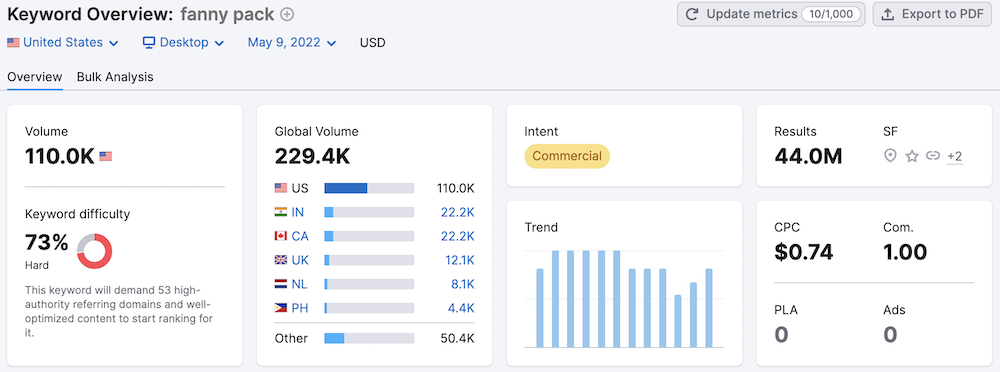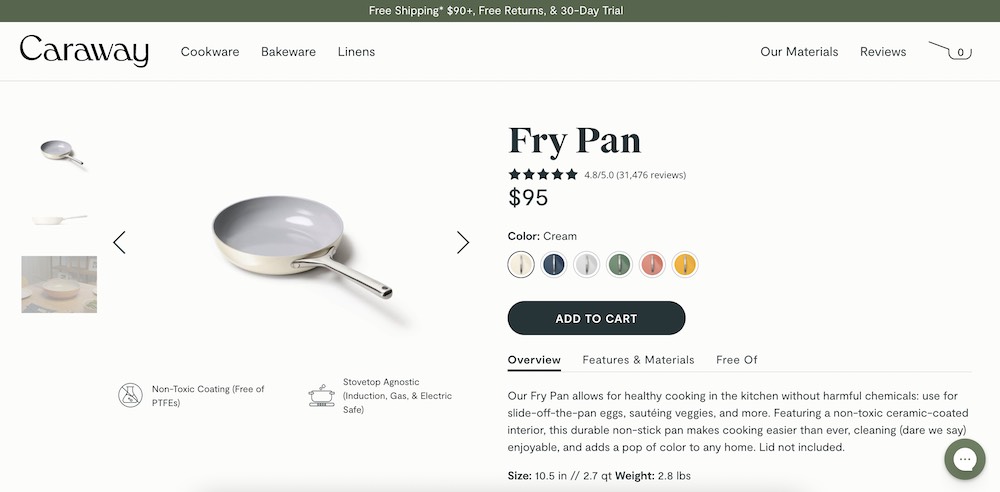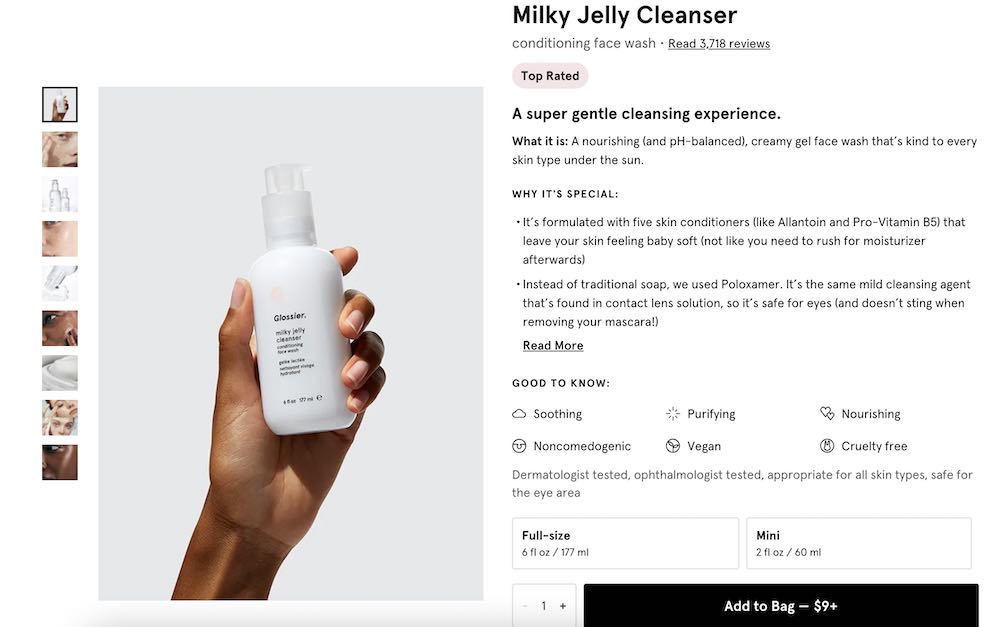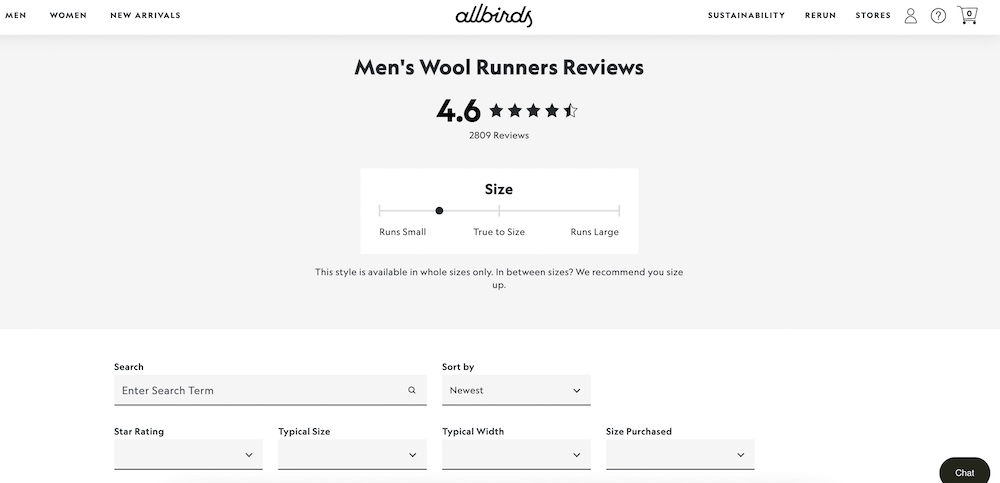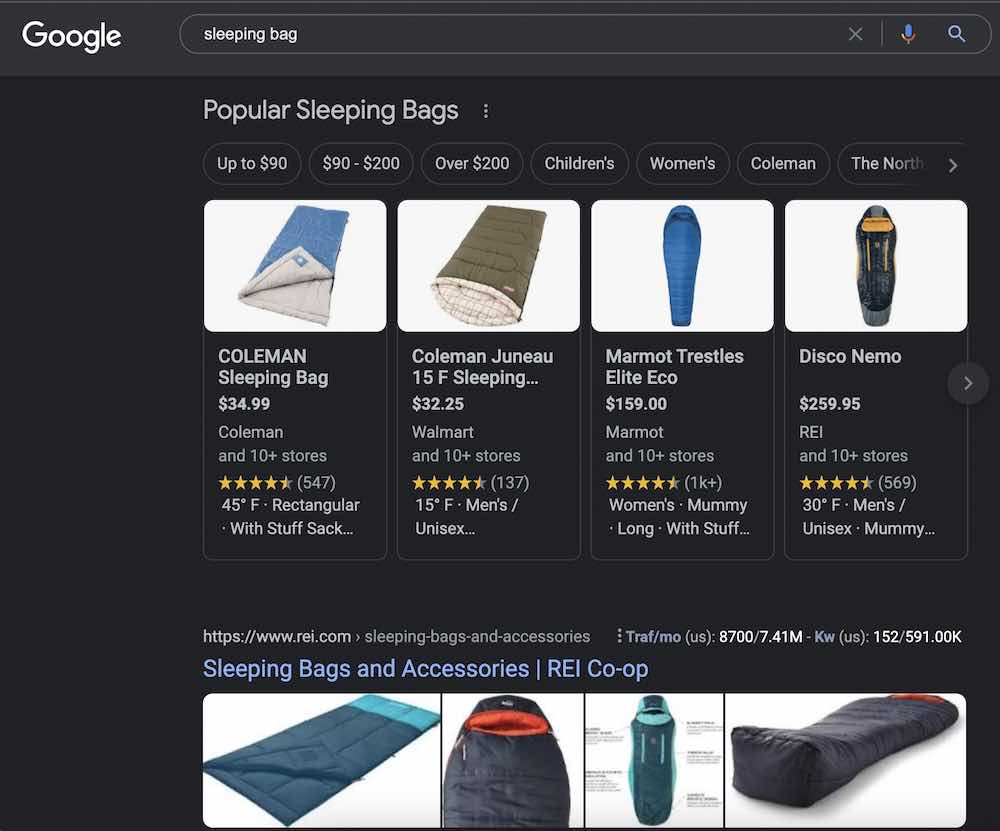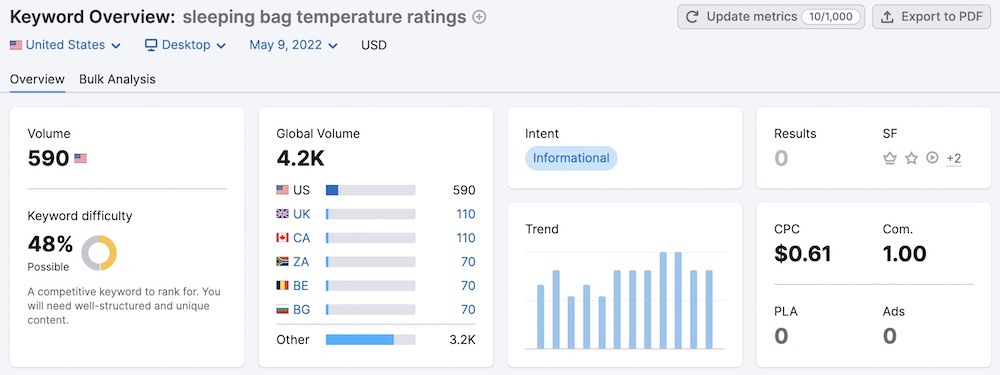An Ecommerce Guide to Optimize Product Page SEO
With so many ecommerce companies using paid search ads, you might be thinking—does product page SEO really matter? The answer is yes.
Businesses need a holistic growth marketing strategy that combines SEO and paid search. It is not an either/or situation – and as a growth marketing agency, we incorporate both strategies for our partners.
Paid search can help you grow fast and stay competitive. If your site is new, it can get you to the top of search results faster. However, you pay for every click that comes to your website. On the other hand, organic search provides sustainability and long-term growth. You don’t pay for clicks, and you could get traffic from SEO-optimized product pages and content years after it was first published.
Here are just a few reasons why organic search is so important to ecommerce businesses.
- In 2021, overall digital ad spending increased 35% to $189 billion.
- As of November 2021, 57% of online shoppers go to Google or YouTube first to research a new product before buying.
What is product page SEO?
A product page is a landing page on your website that provides all the product information that a customer needs to make an informed purchase. Great product pages don’t only provide product information–they are intentionally designed to entice visitors to buy.
Product pages are transactional, meaning that most visitors are in the market to buy. However, that doesn’t mean that they will. If your product pages are not optimized for conversions or SEO, then they aren’t generating nearly as much revenue as they could.
Product page SEO is the practice of optimizing product page descriptions, structure, content, and other elements to increase your visibility and overall organic search traffic. With SEO-optimized product pages, you can rank higher in search results and get more visitors to your site.
How to optimize your product pages
There are a lot of elements to consider when creating product pages–increasing conversions, providing shoppers with product details, creating the best user experience, and more. How does SEO fit in?
SEO’s impact may not be obvious on the page, but it is a key part of why many ecommerce brands have been successful. To optimize your product page SEO, follow these tips.
1. Include keywords in your product names and titles.
What makes a good product page title? It should be descriptive, but also include keywords.
Keywords are the search terms that your potential customers are using when they search for products like yours. To determine if a query is a good keyword for you, conduct keyword research.
Look for terms that have high monthly search volume and low keyword difficulty. For example, if someone is searching for “fanny pack”, the search volume looks like this:
Now, the keyword difficulty, or competition to rank is fairly high, but it’s not impossible to rank. To really develop your keyword strategy, you’ll want to add variations and long-tail keywords.
- A keyword variation might be a description like the available colors “pink fanny pack” or a synonym like “belt bag”.
- Long-tail keywords are queries that have around 4 words or more. They are usually in the form of questions, but not always. Although they aren’t usually product page keywords, they are great for longer-form how-to or informational SEO content.
Now, once you have a list of keywords that are associated with your products, you can create SEO titles.
If you search for “fanny pack” (and many other products), you’ll eventually see Amazon in the results. It’s because Amazon is using product page SEO best practices. Its product listings have specific requirements for titles. If you look at Amazon’s product naming guidelines, you may notice that they are designed for SEO.
For instance, they must include a descriptive keyword, and they have title length limits. Amazon’s title length is 80 characters max, but we recommend under 60.
Here’s an easy-to-use format for creating SEO-friendly product titles:
- Primary Keyword – Description (material, color, or size) – Brand Name
It’s also important to note that you may rank for product category pages with SEO, in addition to individual product pages. Category pages tend to have more general keywords (belt bags and fanny packs), whereas, product pages may be more specific (faux leather belt bag).
2. Make sure your product URL structure is descriptive.
The URL structure of your product pages is more important than you may think. The URL appears at the top of the browser, and although, it may not be read by shoppers as much as your title, search engines are reading it.
Good URL structure helps Google crawl and index your site. Bad URL structure can impact your organic search performance. Common URL issues for ecommerce sites are duplicate and non-descriptive text.
Avoid URLs that look like this:
https://company.com/skincare/collections/product/index.jsp?productId=1234567
It’s long. It includes a lot of numbers that are not descriptive. Plus, it’s missing keywords. Instead, opt for a URL like this:
- https://company.com/product/keyword
Cooking company Caraway does this beautifully. For instance, look at the product page for its fry pan.
The keyword “fry pan” is right in the title and URL. Overall, the URL structure is short, descriptive, and SEO friendly.
3. Use canonical tags to eliminate duplicate content.
Even if you have a consistent, keyword-rich product URL structure, there are common SEO issues that happen with every ecommerce site. This is because ecommerce sites may have many variations of the same product.
For instance, you could have one product, but different sizes, materials, and colors. Each product variation creates a unique URL, even though the content on the page doesn’t change much.
In addition, many ecommerce sites use breadcrumb navigation. The URL structure changes based on how you clicked through the site to eventually land on the product page.
This creates duplicate content issues for ecommerce sites. To solve this, you’ll want to implement canonical tags.
Canonical tags tell Google and other search engines that a specific URL is the master URL.
By implementing rel=canonical tags, you let Google know that it’s not duplicate content.
4. Add unique product descriptions.
If you don’t have unique product descriptions, you’ll run into two major problems–duplicate content and likely, lower conversions. Product descriptions are written first for buyers, not bots.
That said, a good product description for buyers should also be good for SEO. Here are some tips for writing product descriptions for SEO and conversions:
- Include the most important information above the fold.
- Highlight benefits, but provide a bulleted list of product features.
- Include keywords in your product description.
- Put yourself in your buyer’s shoes.
- Make it skimmable–include icons and bulleted lists.
- Eliminate empty words–every word should add meaning to the description.
- Answer common questions–what is the product, what does it do, and why is it worth buying?
For an example of product page descriptions that work, look at Glossier.
The product description for Glossier’s milky jelly cleanser includes all the important information (pricing, sizes, etc.) above the fold. It includes keywords like “conditioning face wash” and “gel face wash” throughout. It is also easy to read with short descriptions, product images, and bulleted lists.
5. Add high-quality product images, but watch out for loading speed.
A fast loading speed is critical to ecommerce websites. Unbounce reports that 70% of shoppers say page speed influences their likelihood of buying from an online store.
Page speed impacts the user experience, and it’s a ranking factor for search engine optimization. Ideally, your pages will load within one to two seconds.
Many factors impact page loading speed, but the size of images is one of the easiest that you can control. The rule of thumb for images is to keep the size below 70 KB.
If you are having a difficult time reducing the size without impacting quality, you can try a smaller image size. You can also change image formats. For example, a JPEG image usually has a much smaller file size than a PNG.
6. Name image files with keywords and add alt text.
Speaking of product images, make sure that when you upload them, they are named descriptively using keywords. For example, instead of adding a product image that is titled “image1.png”, rename it with a descriptive keyword like “blue-fanny-pack.png”
Then, add alt text. This is descriptive text that appears for screen readers, and in case an image doesn’t load on your site. It’s not only important for SEO but for accessibility standards.
7. Embed product videos.
Video content can vastly improve your product page conversions. Combine it with SEO, and you can have more traffic and potential customers.
Sometimes, the best way to describe how your product works is by showing how it works. Site visitors that watch a product video are 73% more likely to buy. Of course, the quality of the product video is important too. Some quick tips for product videos are:
- Keep it short–under 30 seconds.
- Show how your product solves a problem.
- Bring the product to life–go beyond an image and show the product in action.
Another advantage of product videos for SEO is that, if they are set up with schema, they can appear in Google’s rich video snippets. (More on that below.)
8. Add schema markup to appear in rich results.
Google is continuously adding more search results features to help users discover products. Rich results, also called rich snippets, are Google search results that go beyond the basic text and blue link format. They can be image carousels, videos, or interactive elements. Common rich results for ecommerce companies are:
- Product – (Popular Products)
- Reviews – (Star ratings and customer reviews)
To appear in rich results, there are specific product page SEO requirements–mainly structured data or schema markup. You can test whether or not your product pages support rich snippets by adding the link to Google’s Rich Results Test.
9. Include social proof, most importantly reviews.
Out of all the elements on a product page, you can bet that people will read reviews no matter what. In fact, 93% of customers read online reviews before making a purchase.
It is probably obvious by now that reviews influence a customer to buy a product. However, did you know that reviews also impact SEO?
Reviews act as trust signals for customers and search engines. If you feature reviews from real customers on your site, you could be rewarded with a higher search engine ranking.
Allbirds has some of the best product page reviews. For example, on the product page for its men’s wool running shoes, visitors can search inside reviews. It signals that Allbirds cares about customers’ experiences, and makes it easier for new customers to research.
Visitors can sort and filter results to look for past buyers that have similar shoe sizes, widths, and more.
10. Pair product pages with high-quality SEO content.
Product pages are instrumental to any ecommerce site. However, they are designed for people that already have some idea of what they want. In other words, visitors may be in the consideration or conversion stage of the customer funnel already. But, what if a purchase requires a little more education? What if a customer is familiar with a product, but isn’t sure what size or other features they need?
High-quality SEO content like how-to blogs can help educate consumers about your products in ways that product pages can’t.
Take REI for example. The outdoor gear and clothing store is taking a holistic approach to its marketing. You can tell because they appear on the first page of results in paid search, organic results, and rich snippets for highly relevant keywords. It doesn’t cannibalize keywords because each result is different. For example, there are local searches for retail locations and keyword-based results.
In addition, when you search for “sleeping bags”, REI appears in Google’s Popular Products as well as general search results.
Now, in addition to optimizing its product pages for SEO, REI is optimizing content. Using sleeping bags as an example, a question that people searching for sleeping bags often have is what temperature rating do you need?
Temperature ratings are a sleeping bag product feature that new buyers may not be familiar with, so it’s worth educating them through long-form SEO content. In fact, REI does just that. Looking at this blog on How to Choose a Sleeping Bag, you’ll see one of the first sections is “Understanding Sleeping Bag Temperature Ratings”.
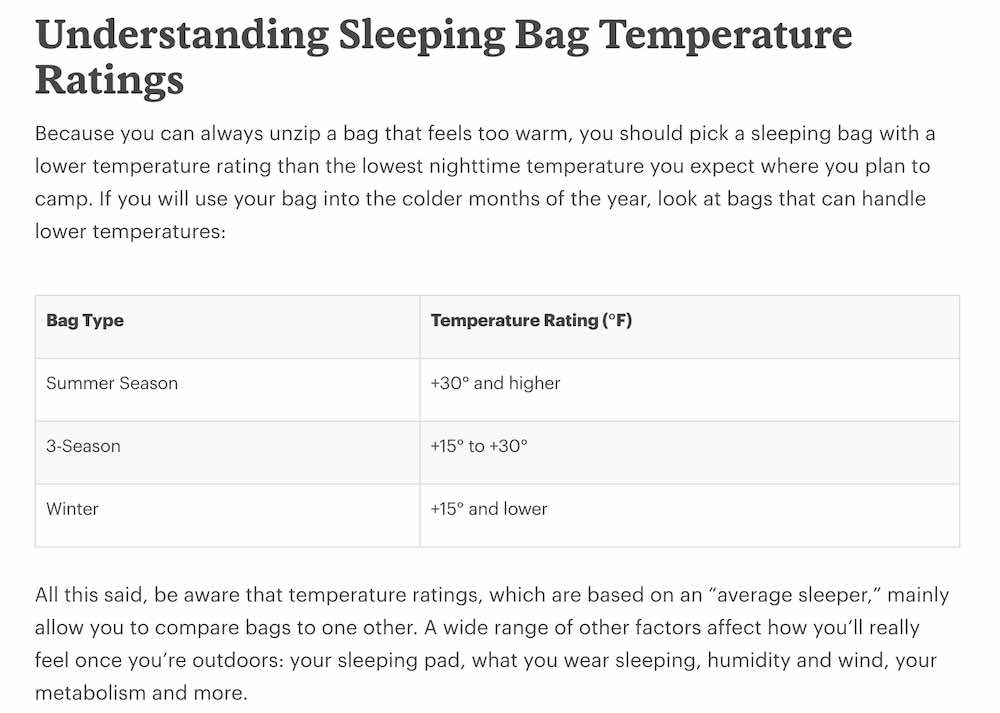
REI is currently ranking for the keyword “sleeping bag temperature ratings”, as well as other sleeping bag-related queries.
Of course, much more goes into optimizing product pages for ecommerce. It’s a good idea to A/B test changes to a product page to see how it impacts conversions. Fixing technical product page SEO issues can be much more complex too. Features like adding structured schema can take a lot of time and attention to detail. These tips can set you on the right path, but if you want to dive deeper, you may want to seek a growth marketing agency with experience in product page SEO to get additional expertise.

